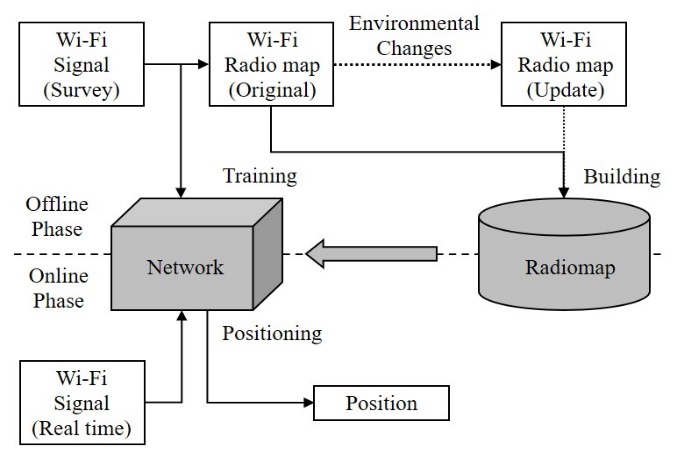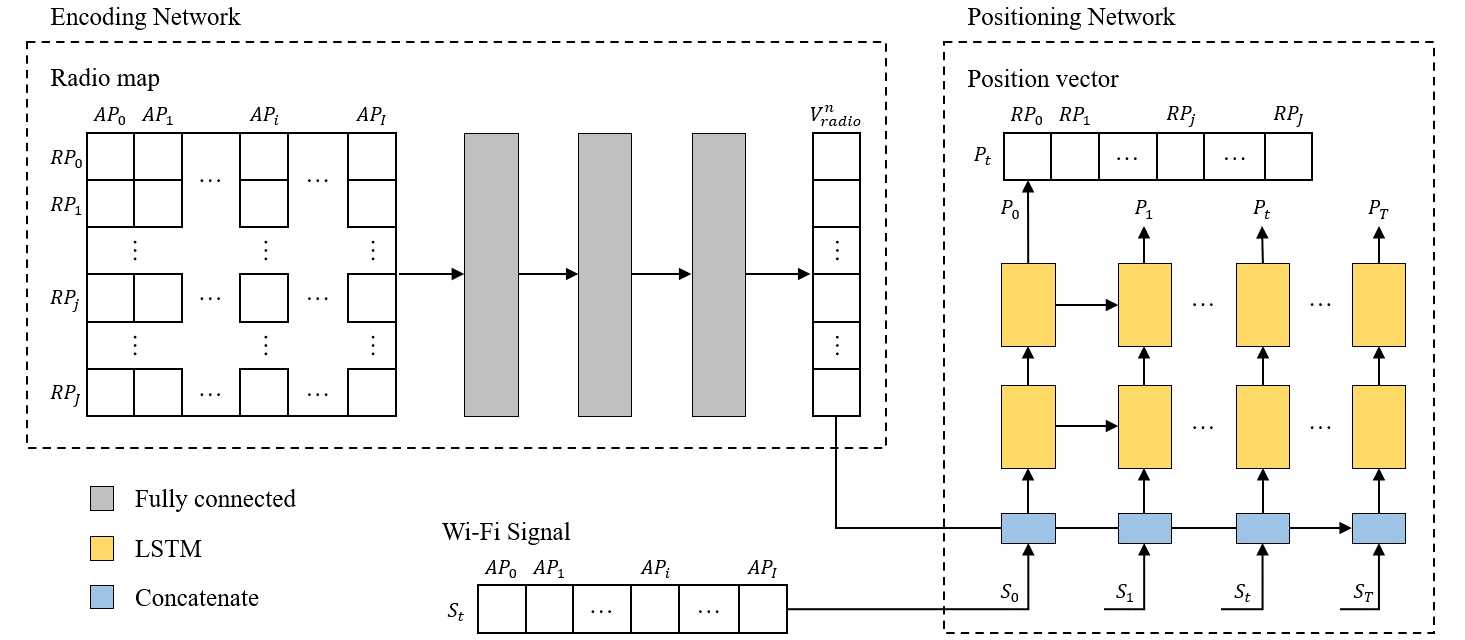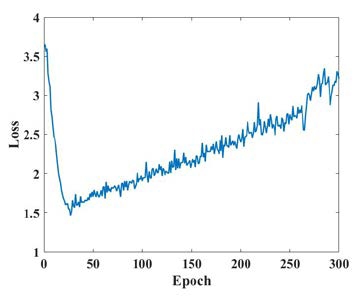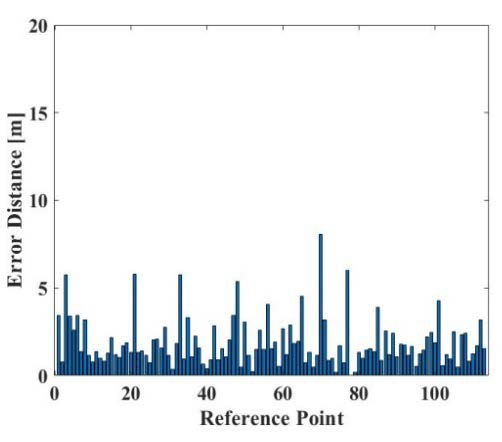
Study on fingerprint positioning network based on radio map encoding
Copyright ⓒ The Korean Society of Marine Engineering
This is an Open Access article distributed under the terms of the Creative Commons Attribution Non-Commercial License (http://creativecommons.org/licenses/by-nc/3.0), which permits unrestricted non-commercial use, distribution, and reproduction in any medium, provided the original work is properly cited.
Abstract
Wi-Fi fingerprints are widely applied in indoor positioning as the indoor environment is generally non-line-of-sight (NLOS). To improve their performance through combination with deep learning, further studies are being actively conducted. Existing deep learning-based fingerprints require relearning when the positioning environment changes owing to the radio map, which is a signal strength pattern, being directly memorized using weights. In this paper, we propose a fingerprint positioning network based on radio map encoding that can rebuild the positioning systems with only a small amount of additional learning by solving this data dependency. The proposed network comprises an encoding network that uses a radio map as a feature vector and a location network that estimates the location based on the measured Wi-Fi signal. By vectorizing the radio map, the encoding network can recover by only remeasurement of the service space even if the environment changes. In addition, as the positioning network estimates the current location by considering the past location, the estimation accuracy is high even when the noise in the Wi-Fi signal becomes severe. This study demonstrated the superiority of the proposed network by comparing it with two other networks and improving the maximum error distance of 1.28 m.
Keywords:
Wi-Fi fingerprint, Deep learning network, Radio map, Indoor positioning, Non-line-of-sight1. Introduction
Global Positioning System (GPS) based location-based service (LBS) is applied in various fields in outdoor environments. However, the use of GPS signals is limited in indoor environments owing to their straightness. Research on indoor location recognition technology is ongoing as GPS is difficult to apply in indoor spaces, where satellite visibility cannot be secured [1]-[2]. Indoor positioning techniques include various wireless communication technologies, such as Wi-Fi [3]-[4], Radio-Frequency Identification (RFID) [5]-[6], Ultra-Wide Band (UWB) [7], Bluetooth [8], and ZigBee [9]. Wi-Fi is the closest technology to commercialization because it has the largest infrastructure among wireless communication technologies for indoor location recognition techniques.
The indoor position recognition method of the Wi-Fi base has the time of arrival (TOA) [10]-[12] to estimate the location of the user utilizing the arrival time of the transmission signal, and the fingerprint [13]-[16] using the relative signal strength according to each access point (AP). However, in a complex indoor structure, a non-line-of-sight (NLOS) environment in which reflection and diffraction frequently occur is common; thus, it is difficult to measure an accurate arrival time. Conversely, a fingerprint, which is located in a pattern of distorted signals owing to the NLOS environment, is most widely applied as it can build a robust system indoors [17]. The fingerprint consists of a training step of creating a “radio map,” which is a database of strengths of wireless signals measured at regular intervals and a positioning step of estimating a location through a radio map [18]-[20].
Recently, there have been several attempts to implement the positioning phase of the fingerprint as a deep learning network [21]-[23]. Such attempts are dependent on learning the building environment by learning the radio map and remembering it as the weight map of the network. In particular, when the radio map is modified, network-based fingerprint is essential to relearning, unlike the existing methods that can be applied immediately. Due to this dependency, the conducted study was limited in terms of accuracy.
Therefore, in this paper, we propose a fingerprint positioning network (FPN) with an encoded radio map to resolve dependencies and build a positioning system that is robust against changes in buildings and APs. The proposed FPN consists of an encoding network that vectorizes a radio map, the vectorized radio map, and a positioning network that estimates the location by analyzing the measured signal strength. The encoding network can achieve the same performance through the additional learning of the small scale in the reconstruction of the radio map as the problem of positioning network being subordinated to one radio map is solved; the radio map, which is a database, is vectorized through deep learning. Simultaneously, the proposed positioning network estimates the measured signal strength sequentially. Therefore, the position estimation accuracy is high with reference to the previous position. The validity of the proposed network was verified by comparing the accuracy with several previously proposed algorithms, and the accuracy and system stability owing to changes in the radio map because of AP location changes was confirmed.
2. Related Work
2. 1 Wi-Fi Fingerprint-based Localization
Wi-Fi fingerprint-based localization is one of the most common methods used for indoor localization. The Wi-Fi fingerprint technique consists of two steps: a training phase to generate the radio map and a positioning phase to estimate the position [24]. In the training phase, the radio map is generated from the received signal strength indication (RSSI) measurement at each reference point. The positioning phase is estimated using the entire radio map generated in the training phase after sampling the signal strengths from the user [25]. The Wi-Fi signals measured at the reference point are used to generate the radio map through preprocessing, such as averaging or partitioning of RSSIs that are attenuated by the relative distance between the transmitter and receiver, and the surrounding structures. The RSSI, which is influenced by the relative distance and presence of obstacles, is an important value for positioning the user's location.
2. 2 Recurrent Neural Network Overview
Recurrent Neural Network (RNN) is an artificial neural network used for data processing with sequential correlations. In the environment where indoor location recognition is used, users move in a continuous trajectory; thus, the current location of the user is related to the previous location. Therefore, using the locus information, which RNN can be created to the sequential RSSI measurement, the stability of the position determination is improved. The Vanilla RNN, which is one of the simplest RNN models, produces a long-term dependency problem that reduces the influence on the initial input time [26]. To mitigate this effect, Long Short-Term Memory (LSTM) is capable of long sequential data learning by dissipating a part of cell state data using a forget gate. However, it has a large amount of operation owing to its complex structure [27]. The gated recurrent unit reduces the forget gate, updates and outputs the gate to update, and resets the gate to improve the operating speed while maintaining the advantages of LSTM [28]. The Bi-RNN, which is an extension of RNN, has high data utilization efficiency by proceeding both forward and backward learning.
3. Fingerprint Positioning Network
3. 1 System Overview
The general fingerprint-based positioning system comprises the offline phase, which collects the signal of the service space, the online phase, which compares the Wi-Fi signal of the user collected through the radio map, and the saved receiver on a real-time basis, and provides the presumed location information and constructed into the radio map. Therefore, if changes in APs or structural changes in space occur, the radio map is rebuilt again through the offline phase. Especially, the neural network-based fingerprint, which has been studied in recent years, has a clear limitation compared to the existing fingerprint because it must relearn all radio maps constructed through the offline phase. In this study, the FPN that is not dependent on the radio map is proposed to solve this limitation. Figure 1 shows the online and offline phase of the proposed positioning system.
In Figure 1, initial radio maps are constructed through the survey that collects Wi-Fi signals and the network is learned through each signal and radio map in the offline phase. After this process is completed, the online phase estimates the location of the measured signal in real-time by comparing it with the stored radio map over the network.
If the location change or the structure change of the AP occurs in the indoor space after the radio map construction, one can update the remeasured radio map similar to the universal fingerprint technique, and rebuild the system through additional learning to the network.
3. 2 Network Architecture
The proposed FPN based on a radio map encoding consists of an encoding network vectoring the radio map and a positioning network estimating the location. Figure 2 shows the architecture of the proposed network and is designed using the layer expressed in the following legend. I/O data is designed to be identical with existing fingerprints to enhance the portability of the system, making it applicable to any environment.
The radio map shows the wireless signal pattern of each location of the service area as a reference for comparison in the positioning process of the fingerprint technique. The existing fingerprints based on the neural network are not stored separately but are memorized as a weight map of the network through learning. This method has the advantage of security and memory because it does not store radio maps separately. However, there is a disadvantage that the entire network should be relearned if the location change of AP or the building structure changes in the service area and the pattern of Wi-Fi signal changes. In this study, to solve this problem, the radio map pattern is encoded as a vector V through a multi-layered Fully Connected Network (FC) without remembering each radio map. A general image-based encoding network is constructed based on the Convolution Neural Network (CNN). However, the network is designed based on FC because it analyzes wireless signals, such as Wi-Fi, where it is difficult to accurately predict coverage. Since the vector V is encoded in the same size as the input Wi-Fi signal, the two data input to the positioning network can be combined in a similarly.
The training process removes some APs from the training dataset and proceeds with the learning so that collection does not overfit the limited radio map. If the built radio map is changed, one can tune it to re-establish the changed data only by further learning, and not re-learning of the entire network, unlike the existing method.
Many studies have applied an approach to estimate the current point of time based on the position of the past point of time because Wi-Fi signals with relatively large noise are unstable to estimate as a result of one point of time. In this study, we propose an LSTM-based positioning network to estimate the current position by considering the past position sequentially. The Wi-Fi signal with high-speed measurement can estimate many locations per second and applying it to the RNN-based network causes a gradient vanishing problem that loses long-term memory. Therefore, in this study, LSTM is applied, and the position is estimated using two layers of LSTM owing to the characteristics of the positioning algorithm where the XOR classification situation occurs. The proposed positioning network inputs Wi-Fi signal S as shown on the right side of Figure 2, and outputs the estimated position P. The estimated position is the probability vector P with a one-hot encoding of each RP.
If the Wi-Fi signal strength falls below -95 dBm, it is judged as not received. Therefore, the network was studied by assuming that the signals that are not input are all -100 dBm for calcu-lation.
4. Experiment and Evaluation
4. 1 Implementation Detail
The proposed network is based on Keras 2.3.1 and Tensor-Flow 1.15.1, and the GPU is NVIDIA RTX TITAN. In this experiment, Adam Optimizer with a learning rate of 0.0001 was applied. Validation Data confirmed the overfitting of this network using 20% of the total data. The total learning was done up to 500 times and ended at the point where the loss and the result indicator, converged. To verify the reliability of the positioning system, the 2nd to 4th floors of the Mieum Campus of Korea Maritime University were used as experimental spaces. In the experiment, the AP was moved and measured for each RP to obtain a radio map modified according to the change in the AP arrangement. RPs were placed at 3 m intervals, and 200 measurements were taken for accurate data collection at each point. This is because the Wi-Fi signal is difficult to distinguish between locations within 3 m owing to noise.
4. 2 Result and Evaluation
The proposed FPN is a multi-class classification problem that outputs the user's existence probability for each location as an individual class through one-hot encoding and softmax. Therefore, the proposed network applies the category cross entropy, which compares classification probabilities between multiple classes, as a loss function. In the experiment, a radio map was constructed by randomly extracting 20 APs to implement a change in AP. Through this, this study checks the performance by separating the radio map into a case where it is learned and a case where it is not learned.
The value of Loss is a category cross entropy, indicating the probability between each classification. Therefore, the closer to 0 the loss is, the more accurate it is, and the higher the loss, the more inaccurate it is. The deep learning model repeatedly inputs data and checks the improvement of accuracy based on Loss; thus, if this number converges to a certain number, training is stopped. The experiment in this study was conducted for a total of 500 epochs, but learning was stopped when the value of Loss did not further decrease. Figure 3 shows up to the suspended 300th learning session.
Here, the x-axis is an epoch, and the y-axis is the cross-entropy learning, which seems to have progressed appropriately because it proceeded quickly within 50 times and then converged below 0.5. An outlier of approximately 260 positions occurs up to ±20% of the learned results, as it uses a gradient decent approach that the learning randomly progresses. When each epoch is terminated, verification is conducted using data that is not used for learning to confirm the overfitting of learning. Figure 4 shows the loss result of this verification process.
The x-axis of Figure 4 is an epoch, and the y-axis is cross entropy. Unlike training loss, the validation loss is rapidly falling and rising again from below 50. Validation results show the overfitting results of the results. The data used in the experiment is the result of a random selection of 20 of all APs in one layer, so the validation data is conducted on unlearned radio maps. Therefore, the more training data is learned, the less accurate the other data is. However, one can recognize the location through the unlearned radio map of Validation data as well as the radio map of training data through the decline below 50 epoch of Figure 4. This result is because the radio map that has not been applied is used. Therefore, the more the learning data is used, the more overfitting the result becomes. Table 1 compares the performance of the proposed network with other algorithms.
The methods in Table 1 are basic fingerprint, Kalman, LSTM, and the proposed method. Here, the proposed method has two results because the situations in which the radio map is trained and the situations where it is not trained are separately expressed. First, the basic fingerprint has an error of approximately 10 m, because no preprocessing has been performed. In contrast, most recent techniques output results of less than 6 m. When the learned radio map is applied, the proposed network has a distance error of 1.89 m and superior performance compared to the latest algorithm. In addition, even when an unlearned radio map is used, it shows a performance of approximately 6 m, and it has a similar level to the basic fingerprint and proves that it has a similar performance even without learning. Figure 5 also shows the mean error distance for each reference point.
In Figure 5, the x-axis and the y-axis are all reference points and average error distance of each position, respectively. Most of the locations have an average error of approximately 2 m, and the maximum error occurs at approximately 8 m. In particular, a large error occurred in the position where the outer wall exists, which can be confirmed through the periodic increase in the error in Figure 5. Figure 6 represents the result of an untrained case.
As shown in Figure 5, the x-axis is the RP and the y-axis is the average error distance of each position; overall, it can be confirmed that the error is large, and there is also a section over 10 m. The error of 10 m is difficult to apply to general location service. However, it is expected to be available for a limited time before constructing a new radio map. In the future, the system can secure the original accuracy through additional learning based on the new radio map for accurate location recognition.
5. Conclusion
In this paper, we propose a deep learning-based FPN for a robust positioning system in the LBS environment. The proposed network is a system that compares the radio map directly with the Wi-Fi signal inputted by vectoring through encoding without remembering it as a weighting value. Unlike existing networks, one can rebuild it only by partial additional learning rather than total relearning. To verify the performance of the proposed network, we measured the learned and untrained areas and showed stable performance with 1.9 m and 5.9 m errors, respectively.
Based on the results of this study, we plan to conduct a study on a robust system for structural changes in buildings.
Acknowledgments
This research was supported by Basic Science Research Program through the National Research Foundation of Korea(NRF) funded by the Ministry of Education(2019R1I1A3A01063290).
Author Contributions
Conceptualization, S. H. Lee; Methodology, S. H. Tae; Software, S. H. Tae and S. H. Lee; Data curation H. I. Seo; Writing-Original Draft Preparation, S. H. Tae; Writing-Review & Editing, S. H. Lee and D. H. Seo; Supervision, D. H. Seo.
References
-
V. Anagnostopoulos, M. Havlena, P. Kiefer, I. Giannopoulos, K. Schindler, and M. Raubal, “Gaze-informed location-based services,” International Journal of Geographical Information Science, vol. 31, no. 9, pp. 1770-1797, 2017.
[https://doi.org/10.1080/13658816.2017.1334896]

-
S. Ray, R. Blanco, and A. K. Goel, “High performance location-based services in a main-memory database,” GeoInformatica, vol. 21 no. 2, pp. 293-322, 2017.
[https://doi.org/10.1007/s10707-016-0278-6]

- W. Le, et al., “A novel Wi-Fi indoor positioning method based on genetic algorithm and twin support vector regression,” The 26th Chinese Control and Decision Conference (2014 CCDC), IEEE, pp. 4859-4862, 2014.
-
J. Machaj, P. Brida, and R. Piché. “Rank based fingerprinting algorithm for indoor positioning,” 2011 International Conference on Indoor Positioning and Indoor Navigation, IEEE, pp. 1-6, 2011.
[https://doi.org/10.1109/IPIN.2011.6071929]

-
A. Montaser and O. Moselhi, “RFID indoor location identification for construction projects,” Automation in Construction, vol. 39, pp. 167-179, 2014.
[https://doi.org/10.1016/j.autcon.2013.06.012]

-
L. Calderoni, M. Ferrara, A. Franco, and D. Maio, “Indoor localization in a hospital environment using random forest classifiers,” Expert Systems with Applications, vol. 42, no. 1, pp. 125-134, 2015.
[https://doi.org/10.1016/j.eswa.2014.07.042]

-
E. García, et al., “DS-UWB indoor positioning system implementation based on FPGAs,” Sensors and Actuators A: Physical, vol. 201, pp. 172-181, 2013.
[https://doi.org/10.1016/j.sna.2013.06.019]

-
H. Li, “Low-cost 3D bluetooth indoor positioning with least square,” Wireless Personal Communications, vol. 78, no. 2, pp. 1331-1344, 2014.
[https://doi.org/10.1007/s11277-014-1820-1]

-
J. V. Marti, et al., “Localization of mobile sensors and actuators for intervention in low-visibility conditions: The ZigBee fingerprinting approach,” International Journal of Distributed Sensor Networks, vol. 8, no. 8, p. 951213, 2012.
[https://doi.org/10.1155/2012/951213]

-
S. G. Nagarajan, P. Zhang, and I. Nevat, “Geo-spatial location estimation for Internet of Things (IoT) networks with one-way time-of-arrival via stochastic censoring,” IEEE Internet of Things Journal, vol. 4, no. 1, pp. 205-214, 2016.
[https://doi.org/10.1109/JIOT.2016.2641902]

-
M. Shalaby, M. Shokair, and M. W. Messiha, “Performance enhancement of TOA localized wireless sensor networks,” Wireless Personal Communications, vol. 95, no. 4, pp. 4667-4679, 2017.
[https://doi.org/10.1007/s11277-017-4112-8]

-
O. Daniel, H. Wymeersch, and J. Nurmi, “Dela-accuracy tradeoff in opportunistic time-of-arrival localization,” IEEE Signal Processing Letters, vol. 25, no. 6, pp. 763-767, 2018.
[https://doi.org/10.1109/LSP.2018.2826470]

-
C. Wu, Z. Yang, and C. Xiao, “Automatic radio map adaptation for indoor localization using smartphones,” IEEE Transactions on Mobile Computing, vol. 17, no. 3, pp. 517-528, 2017.
[https://doi.org/10.1109/TMC.2017.2737004]

-
C. Luo, L. Cheng, M. C. Chan, Y. Gu, J. Li, and Z. Ming, “Pallas: Self-bootstrapping fine-grained passive indoor localization using Wi-Fi monitors,” IEEE Transactions on Mobile Computing, vol. 16, no. 2, pp. 466-481, 2016.
[https://doi.org/10.1109/TMC.2016.2550452]

-
J. Zuo, S. Liu, H. Xia, and Y. Qiao, “Multi-phase fingerprint map based on interpolation for indoor localization using iBeacons,” IEEE Sensors Journal, vol. 18, no. 8, pp. 3351-3359, 2018.
[https://doi.org/10.1109/JSEN.2018.2789431]

-
Y. Zhuang, Y. Li, L. Qi, H. Lan, J. Yang, and N. El-Sheimy, “A two-filter integration of MEMS sensors and Wi-Fi fingerprinting for indoor positioning,” IEEE Sensors Journal, vol. 16, no. 13, pp. 5125-5126, 2016.
[https://doi.org/10.1109/JSEN.2016.2567224]

-
J. Torres-Sospedra, et al., “Ensembles of indoor positioning systems based on fingerprinting: Simplifying parameter selection and obtaining robust systems,” 2016 International Conference on Indoor Positioning and Indoor Navigation (IPIN), IEEE, pp. 1-8, 2016.
[https://doi.org/10.1109/IPIN.2016.7743679]

-
K. Chen, C. Wang, Z. Yin, H. Jiang, and G. Tan, “Slide: Towards fast and accurate mobile fingerprinting for Wi-Fi indoor positioning systems,” IEEE Sensors Journal, vol. 18, no. 3, pp. 1213-1223, 2017.
[https://doi.org/10.1109/JSEN.2017.2778082]

-
Q. Chen, D. Ding, and Y. Zheng, “Indoor pedestrian tracking with sparse RSS fingerprints,” Tsinghua Science and Technology, vol. 23, no. 1, pp. 95-103, 2018.
[https://doi.org/10.26599/TST.2018.9010026]

-
J. H. Seong and D. H. Seo, “Selective unsupervised learning-based Wi-Fi fingerprint system using autoencoder and GAN,” IEEE Internet of Things Journal, vol. 7, no. 3, pp. 1898-1909, 2019.
[https://doi.org/10.1109/JIOT.2019.2956986]

-
X. Jiang, et al., “FSELM: Fusion semi-supervised extreme learning machine for indoor localization with Wi-Fi and bluetooth fingerprints,” Soft Computing, vol. 22, no. 11, pp. 3621-3635, 2018.
[https://doi.org/10.1007/s00500-018-3171-4]

-
X. Wang, et al., “CSI-based fingerprinting for indoor localization: A deep learning approach,” IEEE Transactions on Vehicular Technology, vol. 66, no. 1, pp. 763-776, 2016.
[https://doi.org/10.1109/TVT.2016.2545523]

-
R. S. Campos, L. Lovisolo, and M. de Campos, “Wi-Fi multi-floor indoor positioning considering architectural aspects and controlled computational complexity,” Expert systems with applications, vol. 41, no. 14, pp. 6211-6223, 2014.
[https://doi.org/10.1016/j.eswa.2014.04.011]

-
J. H. Seong and D. H. Seo, “Real-time recursive fingerprint radio map creation algorithm combining Wi-Fi and geomagnetism,” Sensors, vol. 18, no. 10, pp. 3390, 2018.
[https://doi.org/10.3390/s18103390]

- H. Li, L. Sun, H. Zhu, X. Lu, and X. Cheng, “Achieving privacy preservation in Wi-Fi fingerprint-based localization,” IEEE INFOCOM 2014-IEEE Conference on Computer Communications, IEEE, pp. 2337-2345, 2014.
- Z. C. Lipton, J. Berkowitz, and C. Elkan, “A critical review of recurrent neural networks for sequence learning,” arXiv preprint, arXiv:1506.00019, , 2015.
-
S. Hochreiter and J. Schmidhuber, “Long short-term memory,” Neural Computation, vol. 9, no. 8, pp. 1735-1780, 1997.
[https://doi.org/10.1162/neco.1997.9.8.1735]

-
K. Cho, B. Van Merrienboer, C. Gulcehre, D. Bahdanau, F. Bougares, H. Schwenk, and Y. Bengio, “Learning phrase representations using RNN encoder-decoder for statistical machine translation,” arXiv preprint, arXiv:1406.1078, 2014.
[https://doi.org/10.3115/v1/D14-1179]

-
M. Schuster and K. K. Paliwal, “Bidirectional recurrent neural networks,” IEEE transactions on Signal Processing, vol. 45, no. 11, pp. 2673-2681, 1997.
[https://doi.org/10.1109/78.650093]

-
D. Li, B. Zhang, and C. Li, “A feature-scaling-based k-nearest neighbor algorithm for indoor positioning systems,” IEEE Internet of Things Journal, vol. 3, no. 4, pp. 590-597, 2015.
[https://doi.org/10.1109/JIOT.2015.2495229]

-
M. T. Hoang, B. Yuen, X. Dong, T. Lu, R. Westendorp, and K. Reddy, “Recurrent neural networks for accurate RSSI indoor localization,” IEEE Internet of Things Journal, vol. 6, no. 6, pp. 10639-10651, 2019.
[https://doi.org/10.1109/JIOT.2019.2940368]








